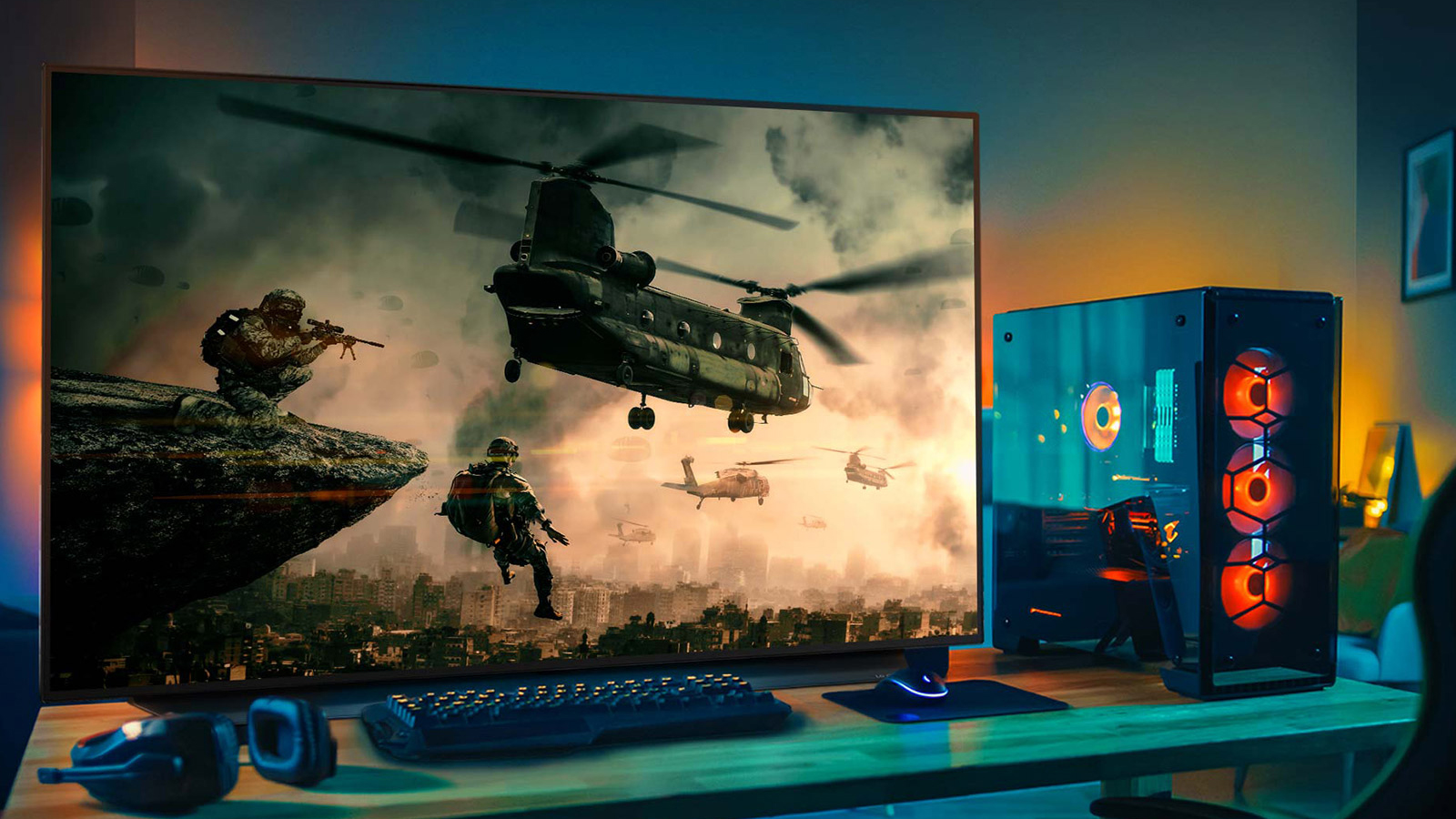In just the past few years, 4K TVs plowed through the market with a ton of features and technologies that made them almost irresistible. T...
In just the past few years, 4K TVs plowed through the market with a ton of features and technologies that made them almost irresistible. The best 4K TVs for gaming are offering high refresh rates and adaptive sync technologies to contend with gaming monitors, but the wide color gamuts and staggering peak brightness levels for HDR on these TVs put most gaming monitors to shame — even our favorite one, the LG UltraGear 38GN950.
A select few gaming monitors borrow TV tech like 10-bit color depths and full-array local dimming to keep up, but these “monitors” are just as large as the TVs they’re competing with. And even smaller monitors do boast HDR specs to compete with TVs, they often cost as much or more than those TVs. This leaves PC gamers who want the best visuals at their desk in a pickle: stick to a smaller monitor without the latest TV tech, pay big-screen prices for a smaller monitor, or just go big. But, how practical is it really to use a TV-sized display as a PC gaming monitor? We decided to find out the hard way.

The setup
We didn’t want to let a poor choice of panel or features skew the results of our experiment against the big display, so we picked up a 55-inch LG CX OLED TV to get one of the most compelling, large gaming screens on the market. The display offers a 120Hz variable refresh rate at 4K with a wide color gamut, high peak brightness, and a contrast ratio no gaming monitor can match. This left its size as the main variable as to how well it worked in our setup.
We mounted the LG CX on our 52-inch wide desk, of which it took up almost the entire width, but we still had space for a desk-size mouse pad for our mouse and keyboard in front of the display. That’ll be a warning flag for some – not every desk is going to be able to hold such a large display.
Setting up a desk space with such a large display is also harder. It’s not easy reaching around to the back of such a big display to plug in HDMI cables or to route USB cables for peripherals. And, of course, hoisting the TV onto the desk can present its own difficulties. If you’re regularly changing things around in your setup, a big screen just makes it harder.
With the TV in position, we were able to use our gaming PC either seated up close at the desk or we could roll our chair back and play at a distance. Since our focus here is how well a large display can serve in place of a gaming monitor and not for couch gaming, though, the ability to play at a distance is just a perk to note.

The experience
The presence of a 55-inch display on our desk was almost immediately overwhelming and took some getting used to. It effectively fills the majority of our field of view. A 34-inch ultrawide gaming monitor might seem fairly expansive, but it pales in comparison to the scale of a 55-inch TV sitting the same distance from our eyes.
As a workspace, it’s almost magical. The ability to move windows to just about anywhere and fit plenty on the display at once can’t be overlooked. But, we quickly found the drawbacks adding up.
4K is for farther away
For one thing, the much-praised 4K resolution that has become ubiquitous in TVs doesn’t hold up so well from the usual viewing distance at a desk. To put things into perspective, a 55-inch 4K TV is akin four 27-inch 1080p monitors, which isn’t the paramount of sharpness. At even arms length, we noticed individual pixels clearly enough. This would be less of an issue on a 48-inch display or 43-inch like Gigabyte’s Aorus FV43U. But even in the case of a 43-inch display, you’re looking at a pixel density of 102 PPI that falls short of the 27-inch 1440p monitors that are almost a staple in PC gaming.
The ability to peep pixels on that granular level hurts the gaming experience some, too. Though having a lot of graphics in motion helps distract from each pixel, it still stands out when we stop to appreciate the fine details in games. If you hate seeing jagged edges because of weak anti-aliasing, you won’t stand for this.
Bright for our eyesight
While there’s no knocking a wider color gamut, the high peak brightnesses of big screens is also a different experience up close. The LG CX isn’t the brightest TV you can get, as OLEDs are more about contrast ratio where QLED TVs are doing more for peak brightness, but the display is still a lot brighter than the many VESA DisplayHDR 400 monitors popping up on the market. Despite not being the brightest, the LG CX can be a strain on our eyes, and we even went as far as dialing down the brightness levels, which definitely helped with usability.
But, limiting the brightness may defeat the purpose for some. The main thing smaller PC monitors fall behind on (besides size, of course) is brightness — just have a look at how few monitors below 43 inches earned the DisplayHDR 1000 certification. If the reason for buying a massive display for your PC gaming setup is so you can enjoy higher peak brightnesses but the actual brightness is so high you have to turn it down, is there actually a point in buying that bigger display?
Framing things differently
It’s not all bad, though. We found some perks to the massive size of the display. Playing shooters, the area for scoped fire was so huge, it was incredibly easy to make out targets and keep them in the crosshairs. What might have been a 2X scope gave us the viability of a 4X scope. Similarly, distant details were easier to perceive. That said, the size of the display also meant some part of the scene would be out in our peripheral vision, making those bits harder to see in the heat of the moment.
Since our field of view was so full, the experience was almost like VR — but the motion sickness-inducing kind. Running animations that bring a lot of camera movement were dizzying.
There are some options to tweak the display, though. If the full expanse of the display is useful in some games and a hindrance in others, you don’t have to use the whole display. It’s possible to output video at a different resolution and aspect ratio from the display’s native specs, such as going for a 21:9 or 32:9 area. This could still take full advantage of the display width without expanding so much into the vertical area, and it can be a lot cheaper than ultra-wide options like the Samsung Odyssey G9. It will result in letterboxing, but on a premium display with a high contrast ratio or local dimming, those black bars may not be too distracting (or will be pure black, in the case of an OLED display like the LG CX).

Is it practical or worth it?
While it was an interesting experiment, the up-close-and-personal nature of gaming made a TV-size display feel more absurd than anything. For the few cases where it showed utility, it wasn’t achieved practically. For example, setting up a bunch of windows to work on was still held back by the low sharpness and the reality that only one or two of them would be anywhere close to ergonomically centered. And running at a different aspect ratio and resolution just illustrates that the screen is too large otherwise.
Price comes into the practicality equation, too. The bigger displays that offer high-end features tend to cost a lot. Gigabyte’s Aorus FV43U is on the smaller side and costs $1,100 (£1,000 / AU$1,699), and our review still found it too big for up-close use. The best gaming TVs don’t come cheap either.
None of this is to say you can’t go for a big screen to enjoy PC games on. If you’re setting up your gaming PC in the living room or plan to play at some distance, it can be a great setup. But, for traditional PC gaming at a desk, you’re better off waiting for some of these premium features to eventually make it to the gaming monitor market rather than opting for a big TV or a display acting like a monitor despite having the proportions of a TV.
- Welcome to TechRadar’s PC Gaming Week 2021, our celebration of the greatest gaming platform on Earth. Despite the global pandemic and ongoing GPU shortages, PC gaming has never been more vibrant and exciting, and throughout the week we’ll be reflecting this with a selection of in-depth articles, interviews and essential buying guides.
from TechRadar - All the latest technology news https://ift.tt/3zx7al2
via IFTTT










COMMENTS